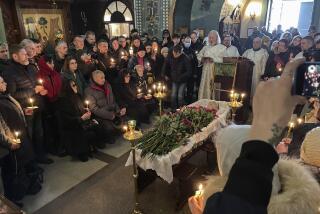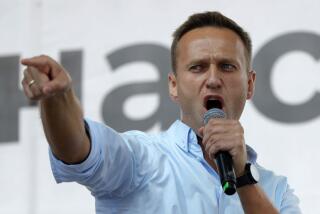Molotov Buried as He Had Lived Since Fall From Power--Quietly, Without Pomp
- Share via
MOSCOW — Under gray, chilly skies, a small retinue of official and private mourners on Wednesday buried Vyacheslav M. Molotov, the chief executor of Josef Stalin’s policies in the 1930s and 1940s, in a place of honor at Novodevichy Cemetery.
Molotov, whose name is linked with the deaths of millions under Stalin’s mass terror, with the forced collectivization of agriculture in the 1930s and with Stalin’s brief alliance with Hitler at the outset of World War II, was buried in a tree-shaded corner of the cemetery next to the grave of his wife.
Burial in Novodevichy Cemetery, which was once reserved for the brightest luminaries of Czarist Russia, is still considered second in honor only to interment in the Kremlin wall.
One Paragraph in Izvestia
Molotov died Saturday at the age of 96. The only official notice of his passing was a brief announcement by the news agency Tass and a one-paragraph report in Tuesday evening’s issue of Izvestia, the government newspaper.
Framed in black, at the bottom of the front page, it noted that “pensioner” V.M. Molotov joined the Communist Party in 1906--nine years before the Bolshevik Revolution--then served as head of government from 1930 to 1941 and as first deputy premier until 1957.
Uniformed police barred reporters and other uninvited visitors from the cemetery, which is surrounded by a high, red-brick wall trimmed in white. There was no outward evidence of an honor guard or other state formalities.
One long black Chaika limousine pulled up to the gates of the cemetery shortly before the service began and an unidentified official, wearing a red and black funeral armband, stepped out. He was followed minutes later by six small buses of the kind ordinary Russians use to transport mourners and the deceased to burial services.
100 at Burial Service
One of the buses, its windows obscured with black curtains, drove into the cemetery, apparently carrying Molotov’s coffin. In all, about 100 people filed into the cemetery for the 2 p.m. service.
Molotov was buried alongside his wife, Polina S. Zhemchuzhina, who was herself a prominent party activist until Stalin, his suspicions aroused by her Jewish origin and her friendship with his own wife, Nadezhda Alliluyeva, ordered her arrested and sent to a Siberian labor camp in 1948.
Molotov, whose unflagging loyalty to Stalin may have been his most distinctive feature, acquiesced in his wife’s sentence on trumped-up charges and continued to serve in the leadership. She was released within a day after Stalin’s funeral, in March, 1953. They resumed their life together and could often be seen strolling arm-in-arm in their elite neighborhood near the Kremlin until her death in 1967.
“Around him (Stalin) a rabble of thin-necked leaders--fawning half-men for him to play with,” the poet Osip Mandelstam wrote with Molotov in mind, in a verse that cost him his life in 1938.
Sensitive Topic
The discretion with which Soviet officialdom has treated Molotov’s passing reflects the enormous sensitivity that still attaches to Stalin and those who served him. The dictator remains officially respected as a wartime leader, but one who made mistakes as yet unspecified in Soviet history books.
According to the dissident historian Roy Medvedev, whose book, “All Stalin’s Men,” was published in the West in 1983 but is prohibited in the Soviet Union, “Molotov played a particularly sinister part in the Ukraine” in 1932, where forced government procurement of grain precipitated a catastrophic famine.
In a newly published book, “The Harvest of Sorrow,” the British historian Robert Conquest estimated that 14.5 million people died as a consequence of Stalin’s agricultural policies, the bulk of them in a famine that Conquest argues was deliberately fomented as a means of crushing Ukrainian national resistance to the confiscation of individual farms.
As the head of government in the 1930s, Molotov also took a direct role in drawing up lists of party figures to be executed or dispatched to Siberia during the purges of the time.
Hitler Handshake
In August, 1939, in the additional role of foreign minister, Molotov negotiated the nonaggression pact with Nazi Germany that bears his name, and in the process gained a grim distinction as the only Soviet leader to shake Adolf Hitler’s hand.
Stalin justified the pact, which evolved to include active Soviet support of the German invasion of France in 1940, as necessary to buy time to prepare Soviet defenses against an eventual German onslaught. But Western leaders considered it a colossal betrayal of anti-Nazi forces that, more than any other factor, emboldened Hitler to launch World War II confident that his eastern flank was secure.
Molotov’s political demise came in 1957, when he aligned himself with the “anti-party group” that sought to overthrow Nikita S. Khrushchev. Expelled from the party, he held a series of minor jobs until his retirement into obscurity in the 1960s. His party membership was restored in 1984.
Although many Soviet intellectuals revile his memory, Molotov remains respected by many other people, who also revere Stalin.
Outside the gates of Novodevichy Cemetery, a man in his 60s who described himself as an “engineer-mechanic,” clutched a bouquet of purple chrysanthemums that he said he wanted to lay on Molotov’s grave. A policeman told him gently that it would not be possible.
‘Made Some Mistakes’
Asked by a reporter if he really approved of Molotov, the man replied, “Yes, he made some mistakes, but I approved of him.”
What mistakes? he was asked.
“Well, he joined the anti-party grouping in 1957.”
But wasn’t the nonaggression pact with the Nazis also a mistake?
“You think so? I don’t. We needed time to prepare for war. It would have come much sooner without the pact. Besides, isn’t it better to negotiate than not? After all, (Soviet leader Mikhail S.) Gorbachev just met with (President) Reagan, even though nothing came of it.”
Did he mean to compare President Reagan to Hitler?
“Well, there is a comparison,” he said, with no trace of anger in his voice. “I think they are both examples of a certain kind of grouping in the West, of monopolists. . . .”
More to Read
Sign up for Essential California
The most important California stories and recommendations in your inbox every morning.
You may occasionally receive promotional content from the Los Angeles Times.













